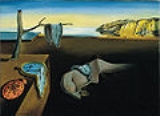
The Persistence of Memory
Overview
The Persistence of Memory is a 1931 painting
by artist Salvador Dalí
, and is one of his most recognizable works. The painting has been in the collection of the Museum of Modern Art
(MoMA) in New York City
since 1934. It is widely recognized and frequently referenced in popular culture.
The well-known surrealist
piece introduced the image of the soft melting pocket watch
. It epitomizes Dalí's theory of "softness" and "hardness", which was central to his thinking at the time.
Painting
Painting is the practice of applying paint, pigment, color or other medium to a surface . The application of the medium is commonly applied to the base with a brush but other objects can be used. In art, the term painting describes both the act and the result of the action. However, painting is...
by artist Salvador Dalí
Salvador Dalí
Salvador Domènec Felip Jacint Dalí i Domènech, Marquis de Púbol , commonly known as Salvador Dalí , was a prominent Spanish Catalan surrealist painter born in Figueres,Spain....
, and is one of his most recognizable works. The painting has been in the collection of the Museum of Modern Art
Museum of Modern Art
The Museum of Modern Art is an art museum in Midtown Manhattan in New York City, on 53rd Street, between Fifth and Sixth Avenues. It has been important in developing and collecting modernist art, and is often identified as the most influential museum of modern art in the world...
(MoMA) in New York City
New York City
New York is the most populous city in the United States and the center of the New York Metropolitan Area, one of the most populous metropolitan areas in the world. New York exerts a significant impact upon global commerce, finance, media, art, fashion, research, technology, education, and...
since 1934. It is widely recognized and frequently referenced in popular culture.
The well-known surrealist
Surrealism
Surrealism is a cultural movement that began in the early 1920s, and is best known for the visual artworks and writings of the group members....
piece introduced the image of the soft melting pocket watch
Pocket watch
A pocket watch is a watch that is made to be carried in a pocket, as opposed to a wristwatch, which is strapped to the wrist. They were the most common type of watch from their development in the 16th century until wristwatches became popular after World War I during which a transitional design,...
. It epitomizes Dalí's theory of "softness" and "hardness", which was central to his thinking at the time.
Unanswered Questions

